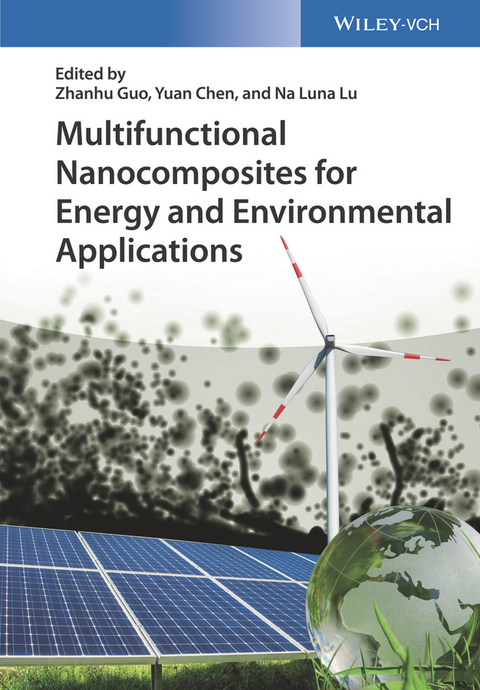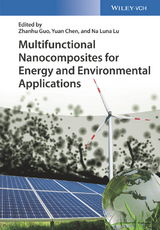Multifunctional Nanocomposites for Energy and Environmental Applications
Wiley-VCH (Verlag)
978-3-527-34213-6 (ISBN)
- Titel ist leider vergriffen;
keine Neuauflage - Artikel merken
Zhanhu Guo is Associate Professor in the Department of Chemical and Biomolecular Engineering at The University of Tennessee, Knoxville, USA. He received his PhD in chemical engineering from Louisiana State University, USA, followed by postdoctoral studies in mechanical and aerospace engineering at the University of California, Los Angeles, USA. He was the Chair of the Composite Division of the American Institute of Chemical Engineers in 2010-2011. Dr. Guo's Integrated Composites Laboratory focuses on multifunctional nanocomposites for energy, environmental and electronic devices applications. Yuan Chen is Professor in the School of Chemical and Biomolecular Engineering at The University of Sydney, Australia. He received his PhD in chemical engineering from Yale University. Before joining The University of Sydney, he was Associate Professor at Nanyang Technological University, Singapore, where he served as Head of the Chemical and Biomolecular Engineering Division in 2011-2014. His research focuses on carbon nanomaterials for sustainable energy and environmental applications. He received several awards including Australian Research Council Future Fellowship in 2017 and Young Scientist Awards by the Singapore National Academy of Science in 2011. Na (Luna) Lu is an associate professor of the Lyles School of Civil Engineering and School of Materials Engineering at Purdue University. She has research interests/ expertise in using nanotechnology to tailor a materials? (electrical, thermal, mechanical, and optical) properties for renewable energy applications, in particular, thermoelectric, piezoelectric and solar cells. Fundamentally, her group studies electron, phonon, and photon transport mechanisms for a given materials system, and designs the transport properties to meet the targeted performance. Her research work has been featured in national and regional media. She is the recipient of a 2014 National Science Foundation Yong Investigator CAREER Award.
Chapter 1: Introduction
Chapter 2: Advanced Nanocomposites Electrodes for Lithium Ion Batteries
Chapter 3: Carbon Nanocomposites in Electrochemical Capacitor Applicant
Chapter 4: Application in Nanostructure Electrodes in Halide Perovskite Solar Cells and Electrochromic Devices
Chapter 5: Perovskite Solar Cell
Chapter 6: Nanocomposite Structures Related to Electrospun Nanofibers for Highly Efficient and Cost Effective Dye Sensitize
Chapter7: Laser Ablation Based Techniques for Solution-phase Synthesis
Chapter 8: Thermoelectric Nano Composite for Energy Harvesting
Chapter 9: Graphene Composite Catalysts for Electrochemical Energy Conversion
Chapter 10: Electrochromic Materials and Devices Fundamentals and Nanostructuring Approaches
Chapter 11: Nanocomposite Photocatalysts for Solar Fuel Production from CO2 and Water
Chapter 12: The Application of Nanocomposite Catalysts in Biofuels Production
Chapter 13: Photocatalytic Nanomaterials for Energy and Environment
Chapter 14: Role of Interfaces at the Nano-architectured Photocatalysts for Hydrogen Production from Water Splitting
Chapter 15: Nanostructures Catalysts for Small Molecule Conversion
Chapter 16: Rational Heterostructure Design for Photo Electrochemical Water Splitting
Chapter 17: Layered Doubled Hydroxides Derived NOx Storage Reduction Catalyst for Vehicle NOx Emission Control
Chapter 18: Applications of Nanomaterial in Nuclear Waste Management
Chapter 19: Electromagnetic Interference Shielding
Chapter 20: Mussel-inspired Nanocomposites Synthesis and Promising Applications in Environmental Fields
| Erscheinungsdatum | 28.02.2018 |
|---|---|
| Verlagsort | Berlin |
| Sprache | englisch |
| Maße | 170 x 244 mm |
| Gewicht | 1652 g |
| Themenwelt | Geisteswissenschaften ► Geschichte |
| Naturwissenschaften ► Chemie | |
| Technik ► Maschinenbau | |
| Schlagworte | Chemie • Chemistry • Energie • Energiespeicherung • Energy • Energy Storage • Festkörperphysik • Nachhaltige u. Grüne Chemie • Nanokomposit • Nanomaterial • Nanomaterialien • nanomaterials • Nanostrukturiertes Material • Nanotechnologie • nanotechnology • Physics • Physik • Solid state physics • Sustainable Chemistry & Green Chemistry • Sustainable Chemistry & Green Chemistry |
| ISBN-10 | 3-527-34213-3 / 3527342133 |
| ISBN-13 | 978-3-527-34213-6 / 9783527342136 |
| Zustand | Neuware |
| Informationen gemäß Produktsicherheitsverordnung (GPSR) | |
| Haben Sie eine Frage zum Produkt? |
aus dem Bereich




